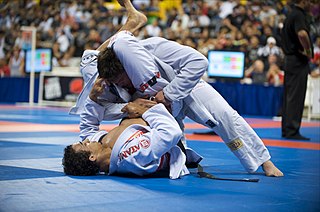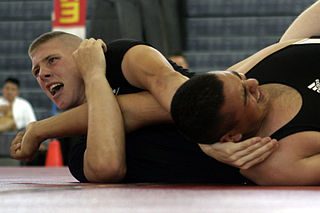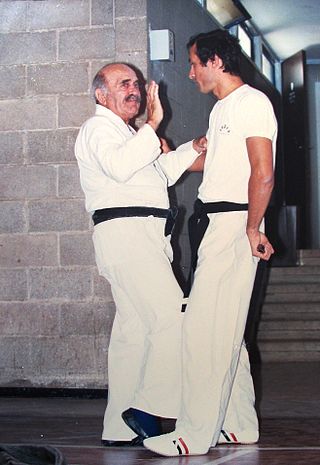Related Research Articles

Capoeira is an Afro-Brazilian martial art that combines elements of dance, acrobatics, music and spirituality. Born of the melting pot of enslaved Africans, Indigenous Brazilians and Portuguese influences at the beginning of the 16th century, capoeira is a constantly evolving art form. It is known for its acrobatic and complex maneuvers, often involving hands on the ground and inverted kicks. It emphasizes flowing movements rather than fixed stances; the ginga, a rocking step, is usually the focal point of the technique. Although debated, the most widely accepted origin of the word capoeira comes from the Tupi words ka'a ("forest") paũ ("round"), referring to the areas of low vegetation in the Brazilian interior where fugitive slaves would hide. A practitioner of the art is called a capoeirista.
Martial arts are codified systems and traditions of combat practiced for a number of reasons such as self-defense; military and law enforcement applications; competition; physical, mental, and spiritual development; entertainment; and the preservation of a nation's intangible cultural heritage.

Calisthenics or callisthenics (/ˌkælɪsˈθɛnɪks/) is a form of strength training consisting of a variety of movements that exercise large muscle groups, such as standing, grasping, pushing, etc. These exercises are often performed rhythmically and with minimal equipment, as bodyweight exercises. They are intended to increase strength, fitness, and flexibility, through movements such as pulling, pushing, bending, jumping, or swinging, using one's body weight for resistance in pull-up, push-up squat ecc.. Calisthenics can provide the benefits of muscular and aerobic conditioning, in addition to improving psychomotor skills such as balance, agility, and coordination.

Brazilian jiu-jitsu is a self-defence martial art and combat sport based on grappling, ground fighting, and submission holds. BJJ approaches self-defense by emphasizing taking an opponent to the ground, gaining a dominant position, and using a number of techniques to force them into submission via joint locks or chokeholds.

Mixed martial arts (MMA) is a full-contact combat sport based on striking, grappling and ground fighting, incorporating techniques from various combat sports from around the world. The first documented use of the term mixed martial arts was in a review of UFC 1 by television critic Howard Rosenberg in 1993.

Vale Tudo, also known No Holds Barred (NHB) in the United States, is an unarmed, full-contact combat sport with relatively few rules. It became popular in Brazil during the 20th century and would eventually evolve into modern Mixed martial arts (MMA). For years "Vale Tudo" was used as a synonym for MMA in Brazil, but the term fell into disuse due to the emergence of stricter rules and the influence of the media to have a more "civilized" name. It is now used to refer to an early, more rules-free stage of the modern sport.
The following outline is provided as an overview of and topical guide to martial arts:

Submission wrestling, also known as Submission grappling or Submission fighting, is a combat sport that focus on clinch and ground fighting with the aim of obtaining a submission through the use of submission holds. The term usually refers to a form of competition and training that does not use the Gi, the "combat kimono" worn in traditional martial arts. No-Gi Brazilian jiu-jitsu (BJJ) is the most well known subset of submission wrestling, with the ADCC Submission Fighting World Championship considered its most prestigious tournament.

Imre "Imi" Lichtenfeld, also known as Imi Sde-Or, was a Hungarian-born Israeli martial artist. He is widely recognized for developing Krav Maga, an Israeli martial art.

Indian clubs, which originated in the Indian subcontinent, are a type of exercise equipment used to present resistance in movement to develop strength and mobility. They consist of juggling club shaped wooden clubs of varying sizes and weights, which are swung in certain patterns as part of a strength exercise program. They can range in weight from a few pounds each to special clubs that can weigh as much as up to 100 pounds. They were used in carefully choreographed routines in which the clubs were swung in unison by a group of exercisers, led by an instructor, similar to 21st-century aerobics or zumba classes. The routines would vary according to the group's ability along with the weights of the clubs being used. When the 19th-century British colonists came across exercising clubs in India, they named them Indian clubs.

Bartitsu is an eclectic martial art and self-defence method originally developed in England in 1898–1902, combining elements of boxing, jujitsu, cane fighting and French kickboxing (savate). In 1903, it was immortalised by Sir Arthur Conan Doyle, author of the Sherlock Holmes mystery stories. Although dormant throughout most of the 20th century, Bartitsu has experienced a revival since 2002.

Carlson Gracie was a practitioner of Brazilian jiu-jitsu. A member of the Gracie family, he was the eldest son of Carlos Gracie, and nephew to Hélio Gracie, founders of Gracie jiu-jitsu.
The Gracie Family are a prominent martial arts family originally from Belém, state of Pará, Brazil whose ancestors came from Paisley, Scotland. They are known for creating the self-defense martial arts system of Gracie Jiu-Jitsu, also known as Brazilian Jiu-Jitsu.
Ido Pariente is an Israeli mixed martial arts fighter and trainer. His nickname is "The Hebrew Hammer". He is one of Israel's top fighters.

A training camp is an organized period in which military personnel or athletes participate in a rigorous and focused schedule of training in order to learn or improve skills. Athletes typically utilise training camps to prepare for upcoming events, and in competitive sports, to focus on developing skills and strategies to defeat their opponents. A military training camp generally refers to the period of boot camp, or further or refresher training.

Oom Yung Doe is a line of Korean martial arts schools founded by John C. Kim. In addition to teaching a broad range of physical movements and self-defense, the training also incorporates meditation, philosophy, and the use of herbal formulas and equipment. Some students describe substantial benefits including self-defense skills, mental and physical health, and improvements in conditions such as asthma, diabetes, rheumatoid arthritis, and blood pressure. Critics, however, accuse the school's founder and instructors of unethical behavior, charging large fees, and pressuring students to commit to long-term contracts. Beginning in the late 1980s, several TV and newspaper reports publicized these accusations, and described the school as a "cult." Kim and four of the organization's instructors were found guilty of conspiracy to commit tax fraud in 1995. Despite those issues, certain benefits of the training such as increased lung capacity and the healing of treatment-resistant back pain have been demonstrated to be effective in clinical settings; and there have also been several news reports publicizing some of the benefits described by the students.

The term suspension training refers to an approach to strength training that uses a system of ropes and webbing called a "suspension trainer" to allow users to work against their own body weight.

Michael “Mike” Dolce is an American trainer, strength and conditioning coach, weight-cut coach, author, nutrition and fitness expert, and motivational speaker. He is a former mixed martial artist.

John Raymond Kavanagh is an Irish martial arts coach, Brazilian jiu-jitsu practitioner and former professional mixed martial artist. His students include fighters such as Conor McGregor, Makwan Amirkhani, and Gunnar Nelson.
Phil Daru is an American former mixed martial artist and college football player. Daru is noted for training UFC fighters, boxers, Olympic athletes, and NFL football players. He was named Best Strength and Conditioning Coach in the State of Florida, 2012/13 and also won the World MMA Awards Trainer of the Year in 2019-20 and 2021.
References
- ↑ "Why Going to the Gym Isn't Enough". 9 March 2015.
- ↑ "The bodyweight exercises to gain strength". 18 March 2015.
- ↑ "The former Cork hurler who swapped All-Ireland medals for 100-mile trail runs".
- ↑ "Why You Should Design a Life—and Workout Plan—That Makes You Uncomfortable". GQ. 2019-01-13. Retrieved 2023-02-02.
- ↑ "EXPLORING MOVEMENT - Ido Portal". London Real. Youtube. Retrieved 3 July 2019.
- ↑ Hayeys, Stephanie (2018-07-07). "The Viral Video Star Behind the Fitness Fad That May Replace CrossFit". The Atlantic. Retrieved 2019-02-07.
- ↑ Cerini, Marianna (2018-06-25). "Movement Culture: Hong Kong's Newest Fitness Trend". The Tatler Asia. Retrieved 2019-02-07.
- ↑ Carey, Ian (2018-03-13). "Ido Portal Training for MMA Debut". MMA News. Retrieved 2019-02-07.
- ↑ Joe Rogan - Conor's Coach talks Training for Khabib and Re-match Possibilities , retrieved 2023-02-02